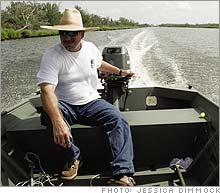|
New Orleans' biggest problem isn't failing levees The Big Easy's best defense is the surrounding wetlands -- and they are dissolving into the sea.
NEW YORK (Fortune) -- Generally speaking, Foster Creppell is not out to change the system. His main gripe about corporate America is that not enough of it stays at Woodland Plantation, the antebellum mansion in Plaquemines Parish that he has transformed into an elegant country bed-and-breakfast. (You may know what Woodland looks like: Its portrait adorns the label of Southern Comfort liqueur.) Nonetheless, Creppell has recently found himself producing eco-warning videos and attending a lot of meetings with people who are much more discontented with things as they are than he. "Nader voters," he says. "People who are Not From Around Here." The reason for the meetings? Plaquemines Parish, an hour southeast of New Orleans, is vanishing into the sea.
In addition to containing America's biggest petrochemical complex, coastal Louisiana also encompasses 40 percent of the nation's coastal wetlands. And all of it - platforms and pipelines, wetlands and Woodland - is rapidly disappearing. Since the Carter administration, according to the U.S. Geological Survey, a landmass about half the size of Rhode Island has vanished. Katrina and Rita alone transformed 225 square miles of marsh into open water, much of it in Plaquemines Parish. The potential consequences are cataclysmic. The barrier islands and wetlands south of New Orleans provide a vital bulwark against hurricanes; without them, the city would be completely exposed to the ocean. By some calculations, Plaquemines Parish and its surroundings - even in their diminished state - may have cut Katrina's surge by as much as six feet. It gets worse: The levees that protect the city from the Mississippi River accelerate the land loss. The Big Muddy carries down huge amounts of sediments from the Midwest. As the river approaches the Gulf of Mexico, the silt settles and builds up, pushing the river mouth ever farther out to sea. Over time this channel grows so long that the Mississippi breaks out and carves itself a new channel, which it builds up anew. The Louisiana coast, a tumble of long, low ridges, is what happens when this cycle repeats itself over millennia. Today, artificial levees protect the city from floods, but they also prevent the river from depositing sediment. Funneled south by its levees, the Mississippi now dumps most of its silt over the edge of the continental shelf. Nothing builds up the land. Exacerbating the problem is Louisiana's huge oil and gas infrastructure: Thousands of miles of pipelines and navigation channels slice through the coastal wetlands, bringing saltwater inland and killing the plants that prevent the wetlands from washing away. Bringing back coastal Louisiana will be an ecological-restoration project of unprecedented scale, complexity, and cost - an estimated $14 billion - but it's doable. The real question is political will. To fund the work, the state has been struggling for years to increase its share of federal oil royalties. Partly by threatening to fight further oil projects in the Gulf of Mexico, Louisiana's congressional delegation seems on the verge of winning a $1.7 billion down payment for coastal rehabilitation. Back in Plaquemines Parish, Foster Creppell is delighted by his state's newfound militancy. People in Louisiana always ask what the state would do without the oil and gas industry, he says. "Well, what are we doing with oil and gas? We've been ripping up the state for 50 years, and we're still poor. This isn't working for us!" (This is an excerpt from a story in the August 21 issue of Fortune, "The Long Strange Resurrection of New Orleans.") Tell us what you think about the reconstruction. ______________________________ Small business owners' manual: Crisis management in hurricanes. |
|


